Intel announces Tunnel Creek - Atom E600 System on Chip
by Brian Klug on September 14, 2010 2:53 PM EST- Posted in
- CPUs
- Intel
- Atom
- Moorestown
- E600
At the end of this morning's keynote at IDF 2010, Intel announced the Atom Processor E600 series. It's a Moorestown-like SoC designed for embedded applications.
Intel is really targeting this SoC at the consumer electronics industry and a variety of applications that could benefit from both better integration. Demonstrations included an E600 SoC powering a car navigation system and a variety of dynamic 3D content or video on a separate passenger entertainment display. You can see it running a PowerVR graphics demo if you look closely in the photo below.
E600 brings everything onboard for the platform, including PCI-E for using the E600 in a multitude of different capacities. Either bring your own PCH or build one yourself - Intel already showed examples of Realtek, OKI, and ST Microelectronics on stage. If you're just building a desktop, Intel has a fairly standard platform controller hub called the EG20T for control like ethernet, SATA and USB. Intel really hopes that their embedded Atom platform will bring cost of system integration way down.
The E-series is a 45 nm part, 32nm and 22nm Atom series parts will follow.



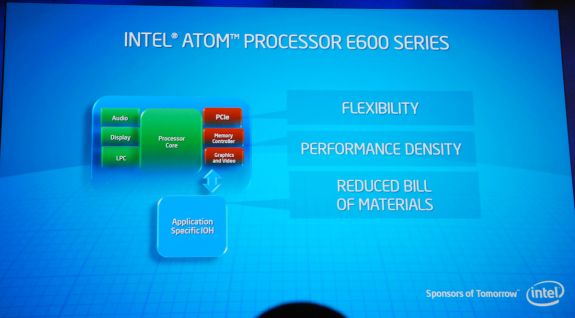
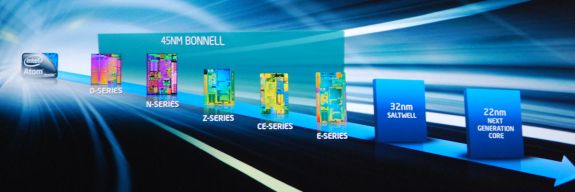
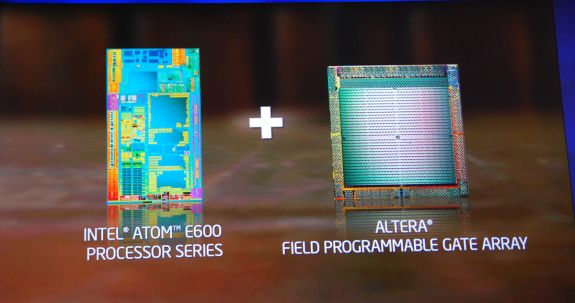
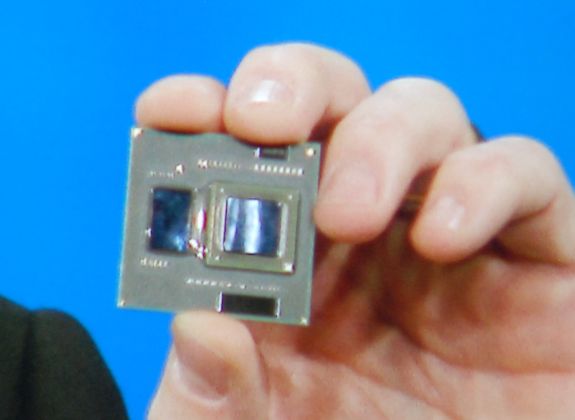
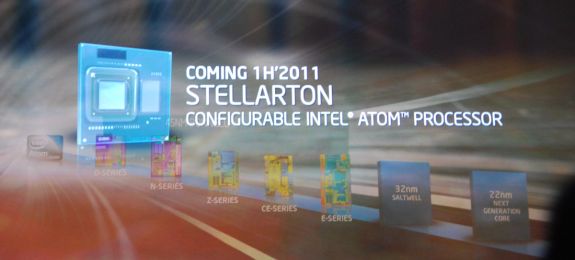








26 Comments
View All Comments
npoc - Tuesday, September 14, 2010 - link
This would be a fun processor to have on a beagle board or other embedded dev system *(arduino).A lot more power than those, but the fpga still makes it interesting.
yyrkoon - Wednesday, September 15, 2010 - link
Perhaps I missed something here, but enlighten me please. What would you want an Atom processor on an Arduino system for ?Spazweasel - Thursday, December 2, 2010 - link
Embedded data acquisition and industrial control computers.lexspop - Tuesday, September 14, 2010 - link
SoC = System on a chip?What does PCH stand for?
Antelopite - Tuesday, September 14, 2010 - link
Platform Controller Hub.http://en.wikipedia.org/wiki/Platform_Controller_H...
There's a reference made to this (EG20T) in the text of the article.
Cheers!
lexspop - Tuesday, September 14, 2010 - link
Much appreciated!vol7ron - Tuesday, September 14, 2010 - link
I can honestly say that I don't know too much about the FPGA.I'm curious how one would use it. Is this used to change the instructions that we commonly see with x86 procs?
Trisagion - Tuesday, September 14, 2010 - link
No you cannot change x86 instructions or anything in the Atom core. An FPGA allows you to add soft cores to work along with the Atom. So for example if you wanted a more powerful video decoder, you could design this at the chip level and write it to the FPGA. If the FPGA is big enough, you might be able to add more than one soft core like an encryption engine or a DSP engine. The FPGA can be reprogrammed, so the possibilities are endless.CorvetteZ0606 - Tuesday, September 14, 2010 - link
FPGAs can be used for all sorts of things. Think of it as a blank peice of silicon that you can program whatever hardware you want onto. Need additional USB controllers? Put that in there. Need a second video card output? put that on there? Need a 10MHz reference oscillator to sync a bus with? put that on there. Need to add a CAN bus, I2C bus, or Dallas 1-wire? put that on there. Raid controller? ditto.Obviously there are trade offs. FPGAs can't hold a huge amount of hardware because they can be programmed with whatever hardware you need at the time. Another problem with them is that they eat power for lunch.
The plus side though is that you're able to bypass the limitation that you have with standard hardware which is what you buy is what you get. With an FPGA, if you have a memory controller for example, you might start out with one that works well, but if the manufacturer finds a bug in the controller that causes it break if it sees a certain pattern in the data, they could issue a new version of the controller that you would apply as a patch. Bug gone.
Things like the intel floating point bug that happened in the Pentium days could be fixed with an update rather than having to replace the chip. (Assuming that the CPU was on an FPGA.)
Personally, I'm really excited about this. I think this is the direction we should be going rather than things like CUDA. Imagine you develop a cool new application that does something amazing, but it takes tons of CPU power and there's no way to optomize it with general purpose instructions found in todays CPUs. Well, you could just write a hardware accelerator for your application and it could interface the CPU and you offload the work to the accelerator. Then when you're done running the program, the OS could unload the hardware and use the FPGA for something else. very cool stuff.
Einy0 - Tuesday, September 14, 2010 - link
It is very cool indeed. I'm not too sure how much FPGAs have advanced recently. Last I knew they where also very clock speed limited. Although you can build some very useful DSPs that run at only 100mhz or so. Obviously you wouldn't want to build a cpu or anything. I guess some of the newer top end stuff can even hit 600mhz. Interesting I could see a very powerful RAID controller built using this type of approach. That'd be cool, having a full x86 CPU on your RAID controller.